| January | February | March |
| April | May | June |
| July | August | September |
| October | November |
Saturday, 14 November 2020

Autumn turns the landscape to shades of brown and golden yellow.
Thursday, 12 November 2020
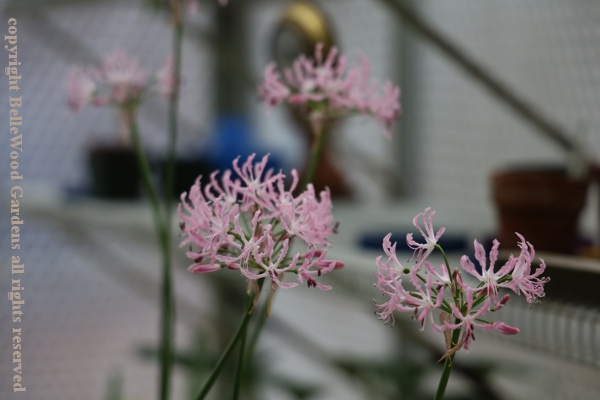
Flowers in the greenhouse: Nerine crispa opens its dainty petals.
Saturday, 17 October 2020
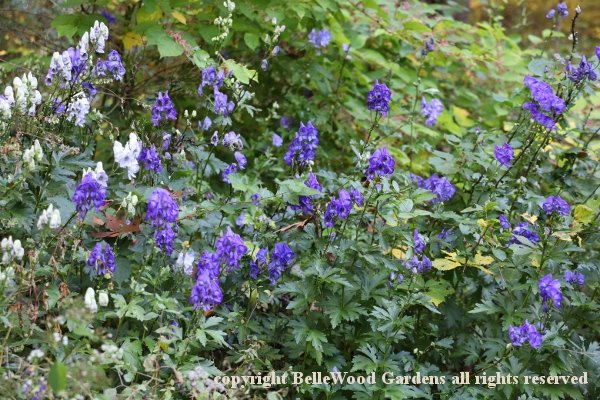
Aconites open their flowers, both the typical rich blue and off-white of 'Cloudy'.

A bumblebee manages to wedge its corpulent body into an aconitum flower.
Wednesday, 14 October 2020

An excellent choice in deer country, aconitum (also known as wolf's bane)
is indeed poisonousd. Deer - so far, and for multiple years - leave it alone.
Monday 14 September 2020

The hillside is rich with flowers and berries as the season starts to wind down.

A closeup of a spray of flowers of Heptacodium, Seven Sons.

Lezpedeza 'Gibralter' is a "cut-back" shrub. Trim to ground and up it comes in spring.

Callicarpa has inconspicuous tiny flowers in spring. Well worth growing
for the clusters of violet fruits in fall. Except this year, for the first time,
a chipmunk climbed up and out on the skinny branches and harvested
every single bead-like berries and carried them away before leaf drop.

I read something that said angel trumpets flower best on V-branched stems.
Shall have to see what happens next year with Brugmansia 'Peach Parfait' .
Friday, 11 September 2020

Brugmansia 'Peach Parfait' is gloriously flowering with pink spattered flowers
that mature to white, deliciously fragrant at day's end. White variegated leaves too.

Heptacodium, Seven Sons, is an end of summer, quite late flowering small tree.

Hydrangea paniculata 'Tardiva' began flowering in August. A blush of pink now appears.

"Tessellated" meaning having a checkered appearance. Certainly applies to these colchicum.
Saturday, 5 September 2020

A group of oxblood lilies, Rhodophiala bifida, skyrocketing into bloom
just a scant few days after repotting and a good drenching from rain
Thursday, 3 September 2020

At the very end of August I repotted these oxblood lilies, Rhodophiala bifida. They had
spent summer dry and dormant in the greenhouse, just an infrequent spritz of water
to maintain their permanent roots. Flowers hurl themselves up in days, leaves follow.

Monday, 31 August 2020
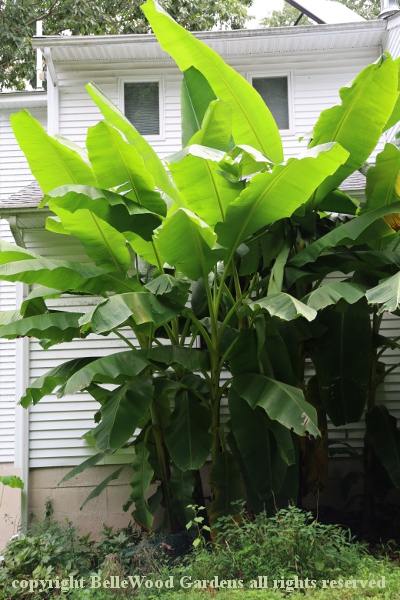
It was May when I uncovered the bananas. They had pale little shoots
poking out of the deep pile of oak leaves. That was then. This is now.

Canna 'Tropicana' is just one of the cannas doing exceptionally well this year.

Red spot banana, Canna flaccida 'Purpurea', an amorphophallis - call it the tropical look.

An interesting hybrid of Amaryllis belladonna and Crinum moorei. Very pink, I'm sure you agree.


Mirabilis jalapa 'Alba' has been providing me with flowers right through the summer.
Easy from seed and little effort keeping dark, dry, and dormant in the basement in winter.
Saturday, 22 August 2020

The label in the pot is Rhodophiala miniata. Problem is there's no such name out there on the Internet. A query and picture sent to the Pacific Bulb Society provided an answer. Shall make a new label for what I now know is Rhodophiala bifida ssp spathacea.

Aptly given the cultivar name of 'Tardiva', this Hydrangea paniculata
flowers a full month later than its other neighboring shrub on the hillside.
Tuesday, 11 August 2020

Once upon a time I had several different rain lilies. Alas I did not bring
the pots I thought I did indoors late last fall. Instead what I do have is a
generous number of pots of Peruvian swamp lily, Zephyranthes candida.
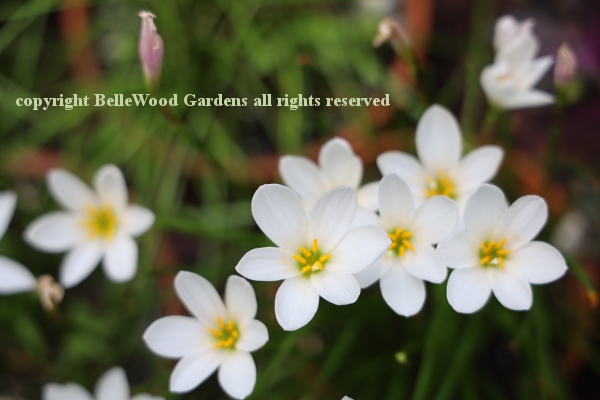
Tuesday, 4 August 2020

I staged these pots on sections of pallets. There is a red spot banana, front right.
Back left is a pot of the deep purple red Canna flaccida 'Purpurea'. The tall lacy
plant is an amorphophallis. Other smaller pots here and there - a fuchsia, a fern.
Luxurious foliage. Guess that could be why I wrote "Consider the Leaf".
Tuesday, 21 July 2020

It has been brutally hot the last few days, temperatures as high
as 95 degrees F. / 35 degrees C. The hardy bananas are loving it.
Saturday, 18 July 2020
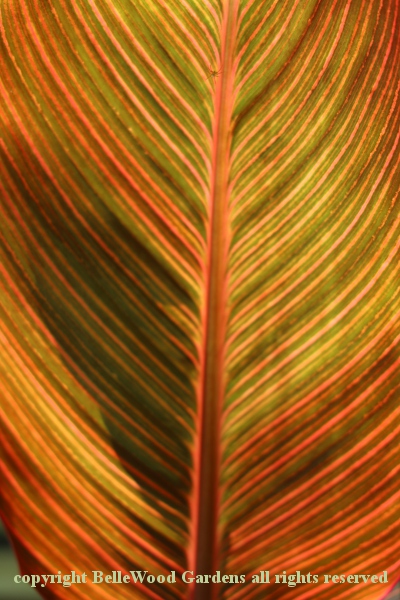
I take this picture every year - a backlit leaf of Canna 'Tropicana'.

A flower of the semi-double daylily, Hemerocallis fulva 'Kwanso'.
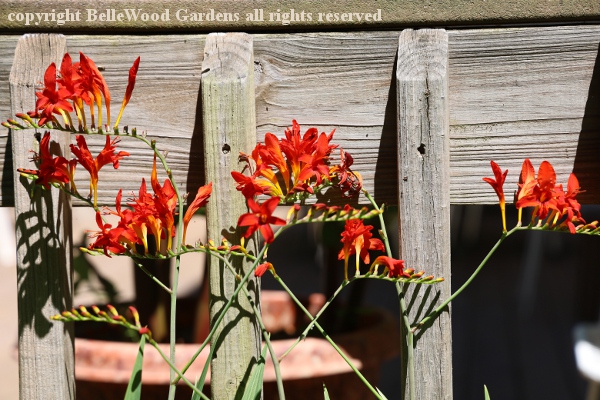
I have a feeling that Crocosmia 'Lucifer' is perhaps too happy and is
multiplying rather enthusiastically. It's only its second year in the ground.
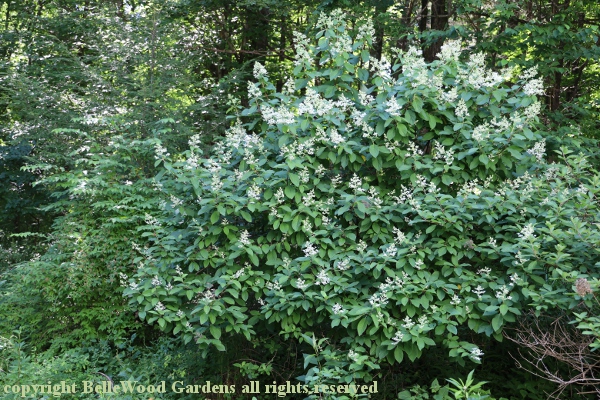
I've never pruned Hydrangea paniculata. It's growing where it has ample
room to grow up and out. And I enjoy its white flower panicles in summer.

Tuesday, 14 July 2020

It was March, rather early in the year, when I planted a number of
Liatris spicata corms among the Pycnanthemum virginianum. Lovely.
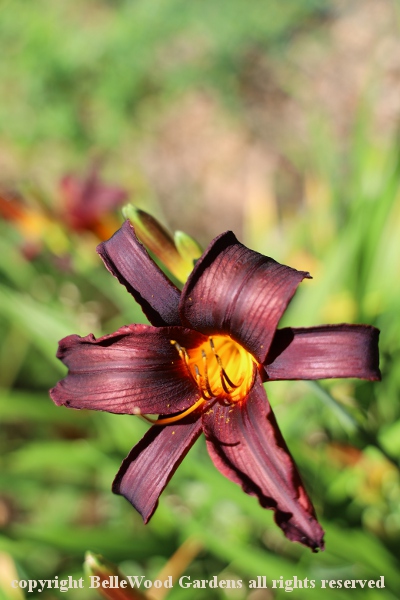
Like hot coals in a fire, the rich yellow center
of dark maroon flower of Hemerocallis 'Africa'.
Saturday, 11 July 2020
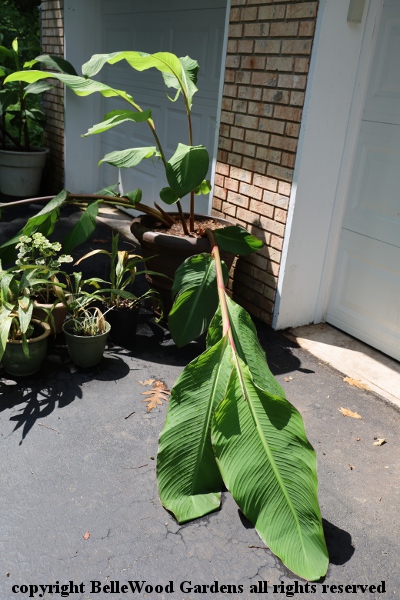
There was a day of heavy rain. Interestingly, the cannas out
in more open places were fine but the Canna musaefolia by
the garage had toppled. Sturdy bamboo stakes and twine

got them back upright with no permanent damage.
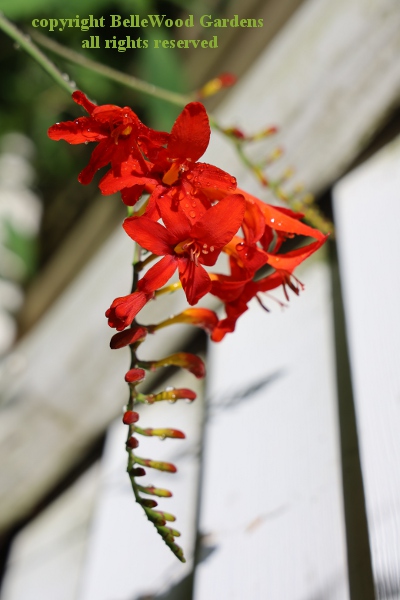
Summer bulbs. We tend to think of tender options,
such as dahlias. Crocosmia 'Lucifer' is hardy, here
in New Jersey, with flowers hummingbirds enjoy also.
Friday, 3 July 2020

Voodoo lily, Sauromatum guttatum, is proving hardier than anticipated.
Not just surviving winter left in the ground, but also multiplying vigorously.
Friday, 26 June 2020

There's an earlier picture of hardy Musa basjoo, taken on June 10. What a difference
two weeks + two days, with rain and summer temperatures makes for these bananas.

Scadoxus multiflorus ssp katherinae has reached full bloom.
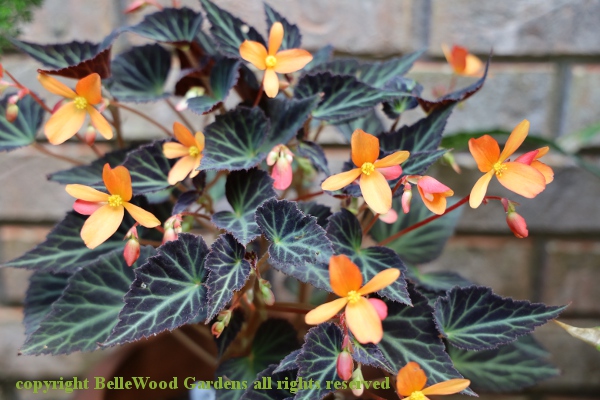
And Begonia 'Sparks Will Fly' is making a good display of warm orange flowers,
nicely displayed against attractive dark bronze leaves with showy light green veins.
Since it is a B. boliviensis it makes a tuber, and insists on a dry winter dormancy.
Tuesday, 23 June 2020
I like cannas, not for their oversize flowers that look so messy as they age

but for their splendid tropical colorful leaves. This yellow striped
beauty is 'Bengal Tiger', or maybe it is 'Pretoria'. Not sure, exactly.

And here is 'Tropicana' with darker burgundy red blotched leaves.
The two images, above, are of cannas potted up from dormancy in May.
I found some smallish overlooked tubers and potted them on June 7.
Sufficient for a bottomless tire planter of each, and growing very well.

Last night the wretched deer came by and decided for the very first time
in all the many years we have lived here, that cannas are on the salad bar.

Monday, 22 June 2020
You probably know and loathe Reynoutria japonica, aka Fallopia japonica or Polygonum cuspidatum. Japanese knotweedfills highway medians, survives most attempts to kill it, and regenerates from the smallest fragment of root or shoot. But there is always one member of any family with better manners.

This is Persicaria polymorpha. It's big. It's bold. And it makes stately clumps,
admittedly large but not intent on taking over and covering the earth. I like it.
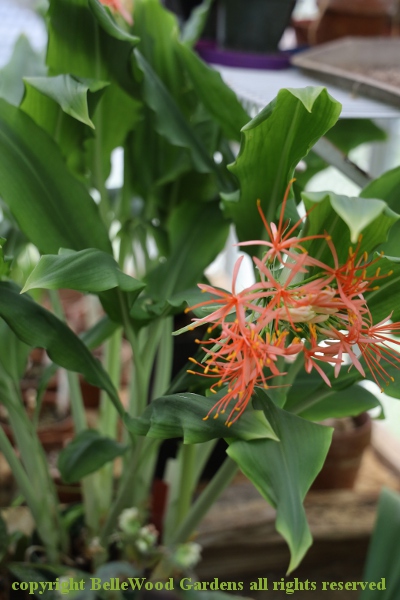
From South African, this bulb is blood lily, Scadoxus multiflorus ssp katherinae.
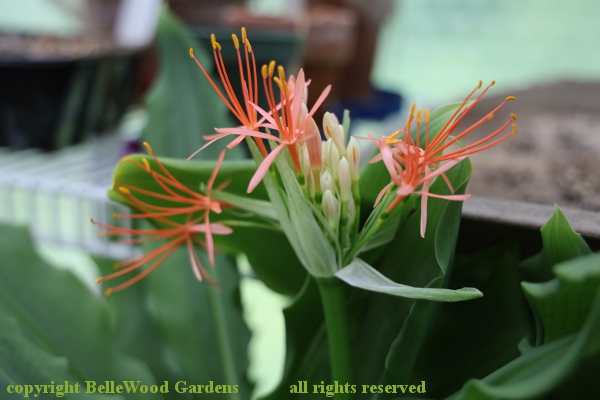
If it flowered first and then sent up its leaves it would have been ssp multiflorus.
Wednesday, 17 June 2020

The four o'clocks are flowering, from afternoon until morning sun gets on them.
This is Mirabilis jalapa 'Orange Crush', with numerous honey yellow flowers.

.

And as you might easily have guessed, this is the cultivar 'Alba'.
Wednesday, 10 June 2020

A month and a week since they were uncovered, and look at how the Musa basjoo
have changed, from pale puny shoots to exuberantly spreading, sail-like green leaves.
Monday, 8 June 2020

In 1991 while doing work at the Jc Raulson Arboretum in Raleigh-Durham, North Carolina,
Richard Hartlege crossed Chinese Sinocalycanthus chinensis with an American species,
Calycanthus floridus. The result C. raulstonii 'Hartlage Wine' with large rose red flowers.
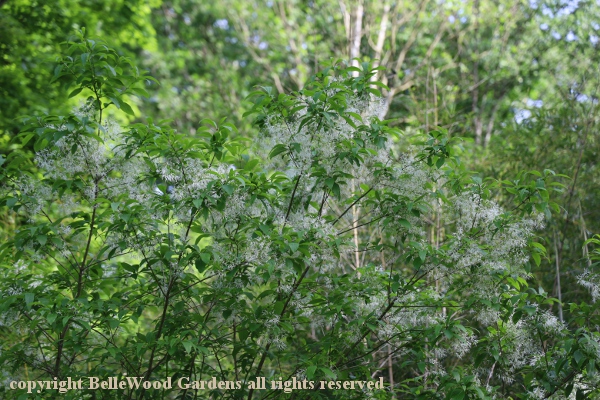
An American beauty, Chionanthus virginicus. Easy to see why the common name
is fringe tree, or old man's beard. Mine has never borne fruit so I suspect it is a male.
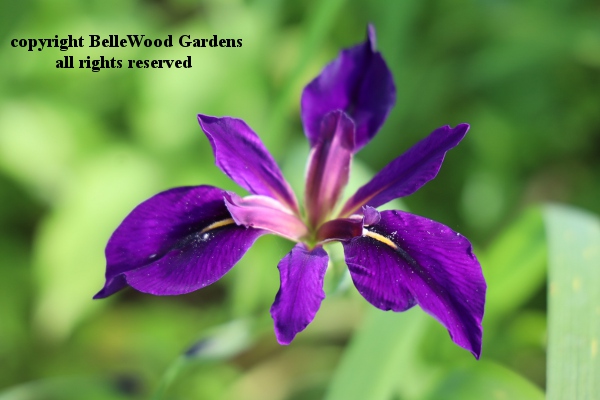
A cultivar of a native American iris, moisture loving Louisiana iris 'Black Gamecock'.

A peculiar little aroid that has proven to be hardier than anticipated. This colony has developed from offsets from the original tuber. Flowers appear first, leaves afterwards. It is Sauromatum guttatum, also known as S. venosum, and Typhonium venosum. Perhaps because it will produce the strange flower sitting unplanted out on a counter it has the common name of voodoo lily.

I do not notice any ill odor but clearly there is something
that attracts this visitation of flies, more than just the color.
Tuesday, 2 June 2020

A late spring flowering shrub, Kolkwitzia amabilis Dream Catcher flowers
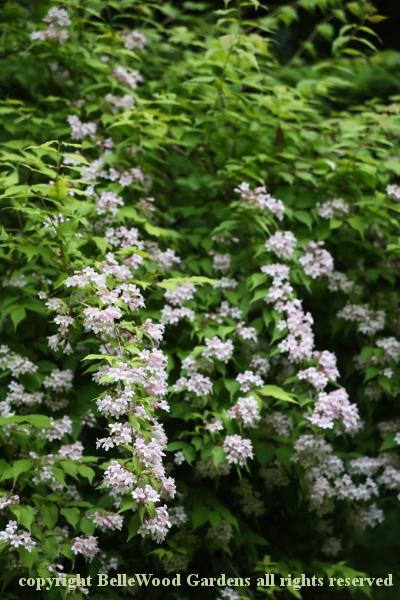
on old wood, as do other spring blooming shrubs such as azaleas, forsythia, and lilacs.

Dream Catcher has attractive chartreuse leaves. Technically, the cultivar name is
'Maradco'. "Dream Catcher" is a proprietary trade name. Guess which name I prefer . . .
Thursday, 27 May 2020
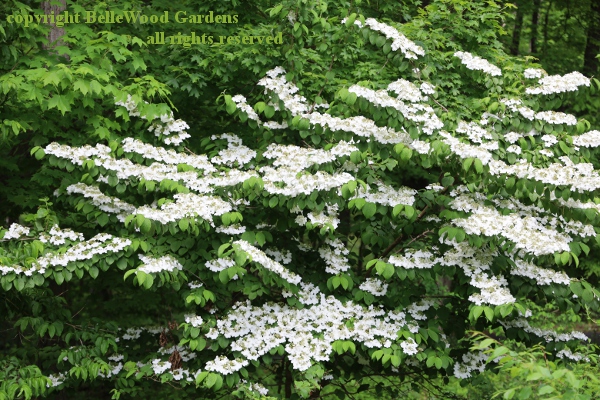
I do prefer the lacy look of Viburnum plicatum 'Mariesii' with its froth of sterile flowers
around the much smaller fertile ones in the cluster's center, layer upon layer of branches.

Silky satiny red petals surround a central boss of golden stamens of a flower on
Paeonia 'Illini Warrior'. And unlike the very full doubles, it can rain and not collapse.
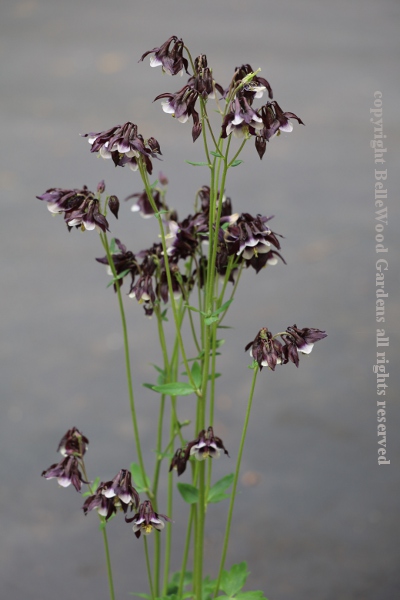
This columbine seeds about, volunteering here and there. And always
with the same dark purple black petals accented with a tip of white.
Wednesday, 20 May 2020
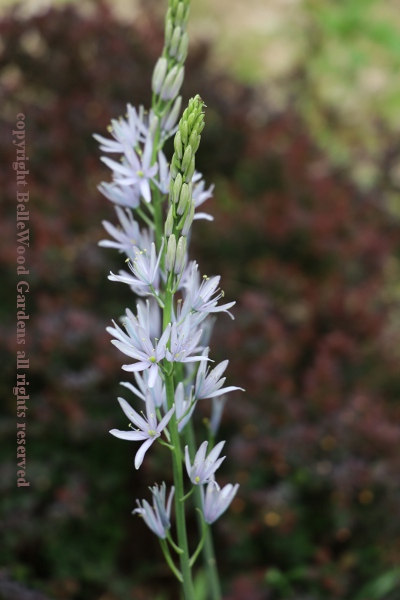
Camassia cusickii doesn't seed about but the original bulb has become two.
Saturday, 16 May 2020

An early little peony with vivid red single flowers and finely cut foliage,
'Early Scout' is a hybrid of the fern leaf peony, Paeonia tenuifolia.

Friday, 15 May 2020
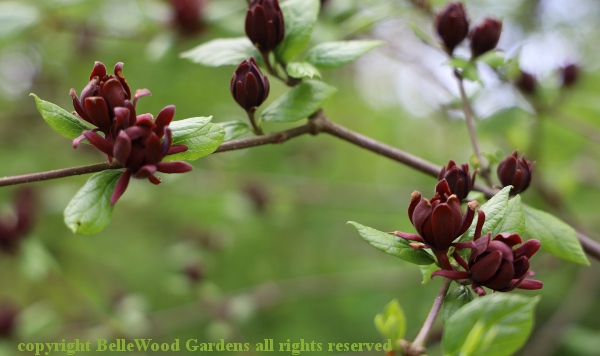
Native, shade tolerant, strange looking, fragrant, dark burgundy flowers -
all are attributes of the easily grown Carolina allspice, Calycanthus floridus.

A woodland peony from Japan, Paeonia japonica 'Alba' happily grows here
at BelleWood Gardens, readily multiplying by means of attractive seeds.
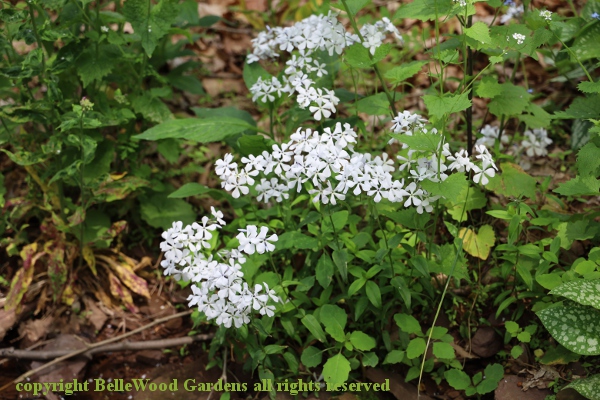
Phlox, all phlox, are native to North America. This is the deciduous woodland
phlox, wild sweet William, Phlox divaricata. It also has a bluish lavender form.

And this is Phlox stolonifera 'Sherwood Purple', the evergreen, spreading species.
Sunday, 10 May 2020
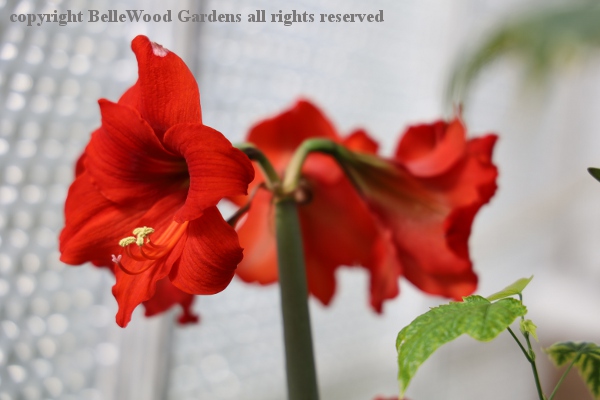
Smaller but intense red flowers of Hippeastrum 'Red Lion' make a good show.
Saturday, 2 May 2020

I decided it might be time to uncover the bananas. Sure enough. Took off
the plywood covers, removed the tubs over the cut back culms and the pale
new shoots were enthusiastically ready to greet the day, straightening up.
Wednesday, 29 April 2020

An old fashioned shrub, perhaps not as showy as popular today.
But I like jet bead, Rhodotypos scandens, for its simple grace.
And the memories of the friend from whose garden they came.

Trillium grandiflorum is making a nice display outdoors in the woodland garden.

Not quite yet open, Arisaema thunbergii variety urashima is
an exotic Japanese Jack-in-the-pulpit. Funky, fanciful, amusing.
Saturday, 25 April 2020
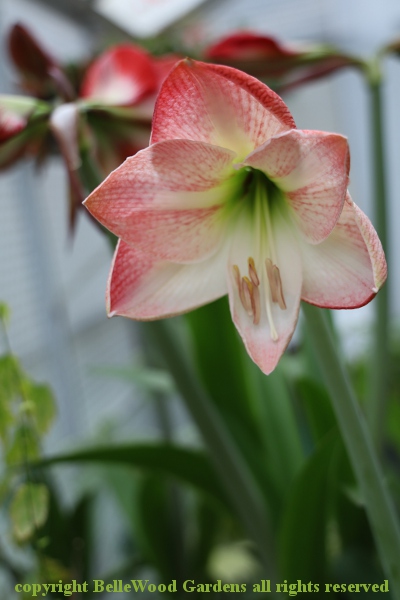
and in just a week to open flower - Hippeastrum 'Charisma'

and an anonymous red hippeastrum whose label
has been lost. Delicate thin edges to petals. Lovely.
Wednesday, 22 April 2020

Just a few days later and the buds are showing color.
Sunday, 19 April 2020

The hippeastrum in my greenhouse have decided it is time to flower.

Thursday, 16 April 2020
Technically, my zone 6 region is not frost free until about Mother's Day, in May.
It is only mid-April so frost may be expected. It has been so mild that I assumed
last night's frost warning would be for the upper 20s Fahrenheit. Wrong. Up on
the roof, where my weather station is located, went down to 22.5° Fahrenheit.
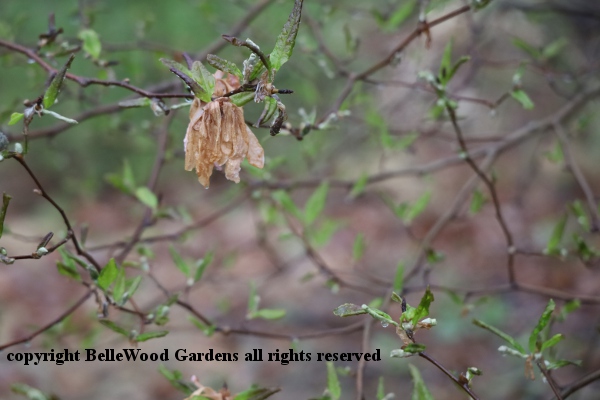
It was more than the pink star magnolia can deal with. It has been in bloom
so well, and for so long, that I really should not complain. Ah well. Farewell.

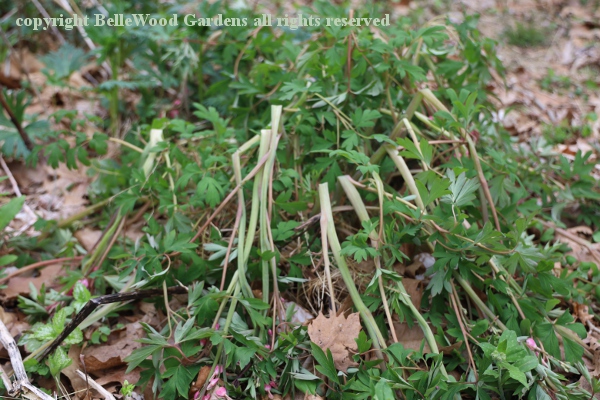
The tall flower stalks of bleeding heart, Dicentra spectabilis, were damaged,
no longer able to hold up their flowers. The foliage looks alright though.
Tuesday, 14 April 2020
A walk in my woods after yesterday's deluge was very rewarding.

All of the various different cultivars of Narcissus poeticus that line the path up to
the Forest Deck are well into bloom. Some are nodding, somewhat leaning over but
still in flower, crisp white petals, little ruffle of a cup banded red, yellow, green heart.

.
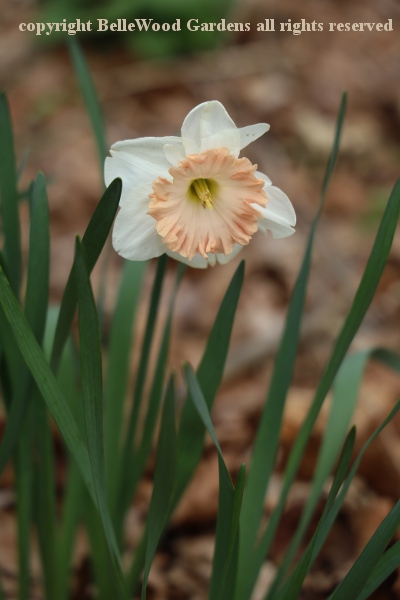
Not quite sure who this daffodil is, or where I got it. But
every year it again rewards me with its ruffled apricot cup.

Small is beautiful. Just admire 'Polar Star'. Flower newly open,
its cool yellow cup will soon fade to white, matching the petals.

Sturdy grape hyacinth, its intense dark blue flowers packing
more punch that you would think its small size could provide.

It's the middle of April, not the middle of June. So don't ask me why this
bulb is named summer snowflake, Leucojum aestivum. Perhaps because
it has a smaller, earlier relative, the spring snowflake, L. vernum, in March.

.
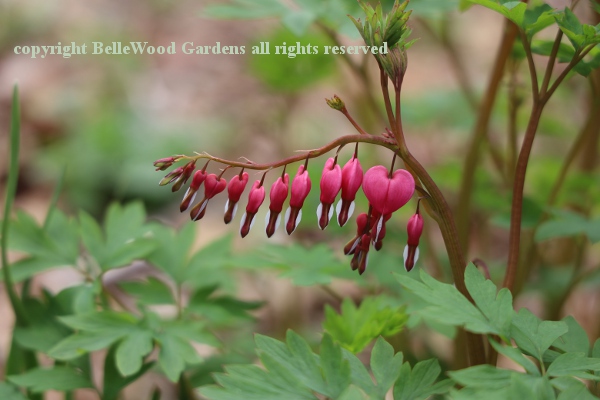
Bleeding heart, Dicentra spectabilis, has a lovely folk tale about its heart-shaped flowers.

There are two native dicentra. This is squirrel corn, Dicentra canadensis,
named for the golden scales of its bulb. Flower has a family resemblance.

Wood anemone, Anemone nemorosa, has a twiggy sort of underground rhizome.
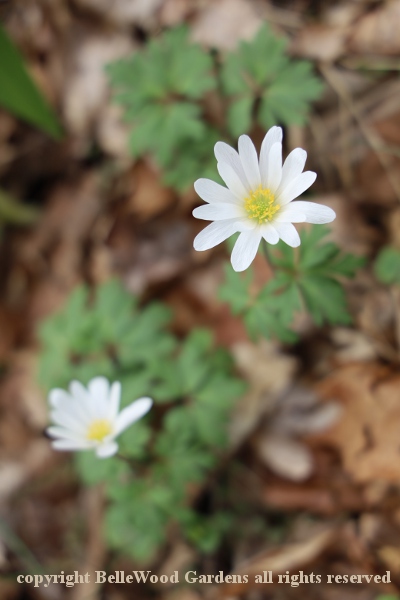
Anemone blanda 'White Splendour' (yes, the "u" belongs. It was
named in England and they spell some things funnily over there)
has flowers that resemble a daisy but it is convergent evolution.

Virginia bluebells, Mertensia virginica, loves dampish soil. Seeds about and multiplies
for me, but difficult to dig, what with its deep roots. Up, flowers, then soon dormant.


Hylomecon japonicum is one of the Japanese woodlanders that delights
with its home in my woods. So many plants from that island nation either
have relatives among our native plants, have become important popular
garden plants (hosta, for one), or thrive so well they are invasive weeds.

Not this pretty golden spring woodlander, neither weedy nor well known.

Sex sells. No, no, I'm referring to flowers, the showy part of a plant that lures the bees
and butterflies to come and pollinate. But for a gardener, foliage may be what makes
a plant worthy of space in the garden. Big leaves splashily marked with yellow gives
Petasites japonicus variegatus a welcome home here in damp soil by the brook.
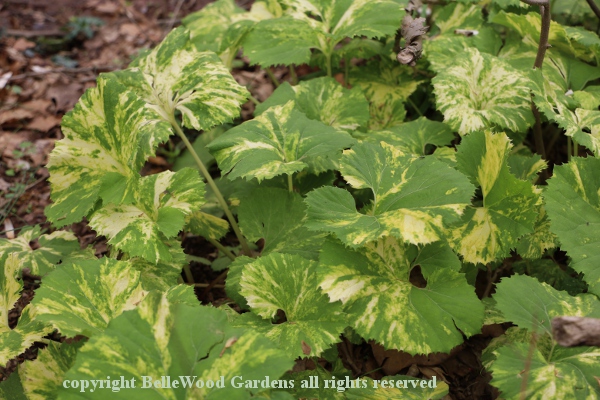
.

Third of this trio of Japanese plants I want to show you today is Primula kisoana.
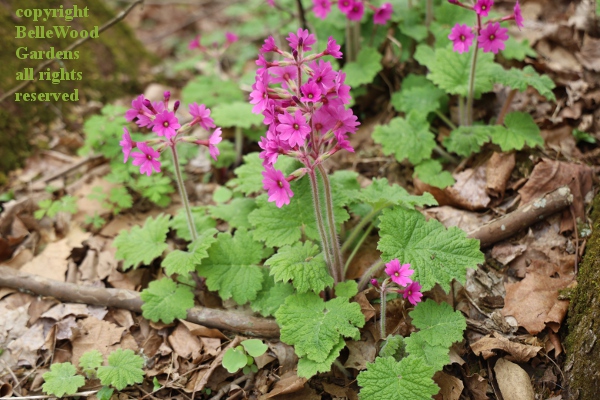
It is different from the primroses you might be familiar with because it has
underground runners that spread the colony, making new plants, nearby.

.

Another lovely foliage plant is Brunnera macrophylla 'Jack Frost' with leaves
covered with silver, like hoarfrost. Macrophylla means big leaf, and these do
expand to the size of my outspread hand. It's not just foliage though. It once

had a different name, the second part of which was mysotidiflora, meaning
the flowers were like a forget-me-not. Which this plant certainly does have.

Native plants. Japanese plants. Deliberately planted plants from other parts
of the world. And those that move in on their own. Which we call weeds. Now,
tell me, if I call it by its Latin name of Taraxicum officinale, and if it were
more difficult to grow, tell me, wouldn't you think dandelion a fine plant to have?
Monday, 13 April 2020
Weather is the game changer when it comes to plants and gardens. The 2019/2020 winter was a mild one with little snow. Growth started early. The continuing steady temperatures - somewhat warm but not dipping bitterly cold made this one of the finest magnolia seasons I can recall. Heavy rain, torrential rain, more than 2 inches in less than 24 hours from midnight last night and on through a good part of Monday, was more than the culverts could handle. Water flowed over the driveway, poured down the driveway, spilled over the downhill side and soured its own tracks down.

The plants appear fine, their roots firm in the ground. The leaf litter that belongs
as ground cover in woodland should be moved back into place where it belongs.
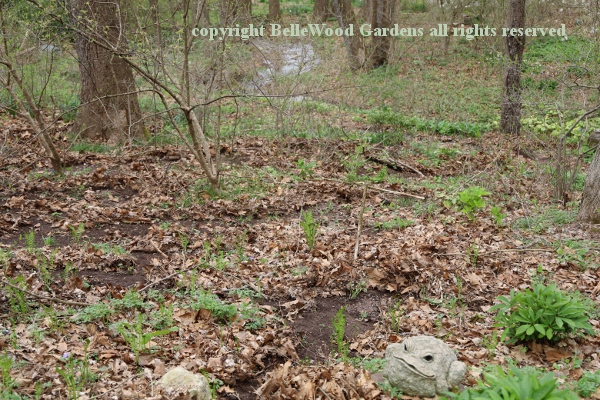
Wednesday, 8 April 2020

To be pollinated a flower needs pollen. The wind blows for free, so plants such as
conifers need not expend resources on pretty petals that lure pollinators. This is
Japanese plum yew, Cephalotaxus harringtonii, ready for the next puff of wind.

The sessile trilliums have made themselves very much at home in my woods.
They even self sow, little single spade like spotted leaves that in a few years
will reach flowering size. Colonies such as this one multiply with clonal offsets.
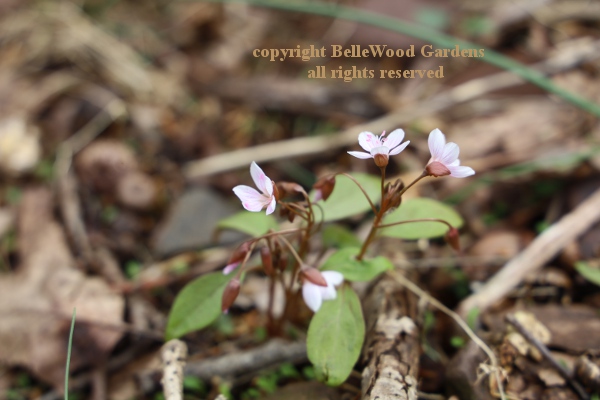
Spring beauty, fairy spuds - Claytonia virginica does appear in the springtime and
tiny tubers are edible. I'd need to dig so many . . . no, I'll just enjoy their flowers.
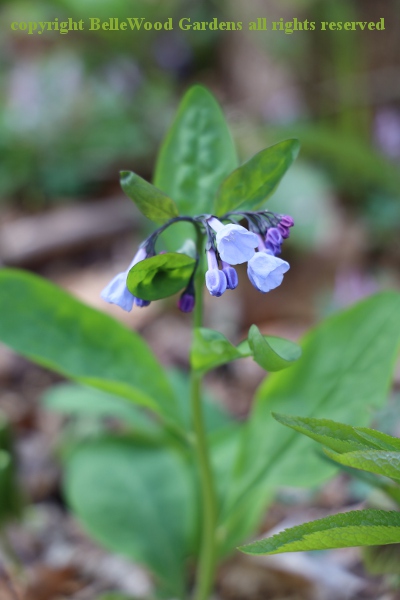
Virginia bluebells, Mertensia virginica, are quite happy in my woods.
They multiply, flower, and vanish - summer dormancy, aestivation.
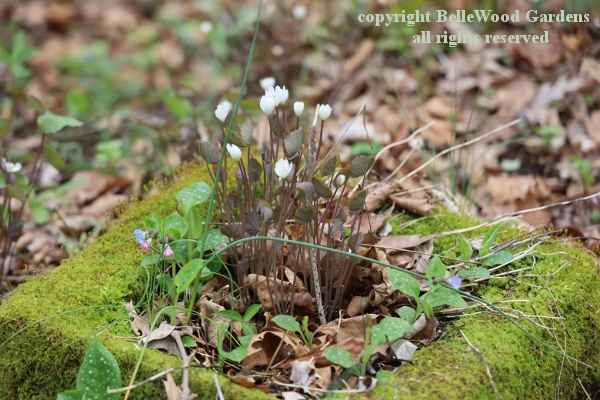
Jeffersonia diphylla is a native, but not locally. The paired leaves will
expand, wing-like, and justify the common name of twin leaf.

The hellebores are still flowering away. Some, especially the H. niger, are setting seed.

Corydalis solida multiplies prolifically but its lacy foliage quickly fades away.

Notice the curlicue tendrils on Fritillaria thunbergii. If they were
growing amidst some other plants stuff they would cling and climb.
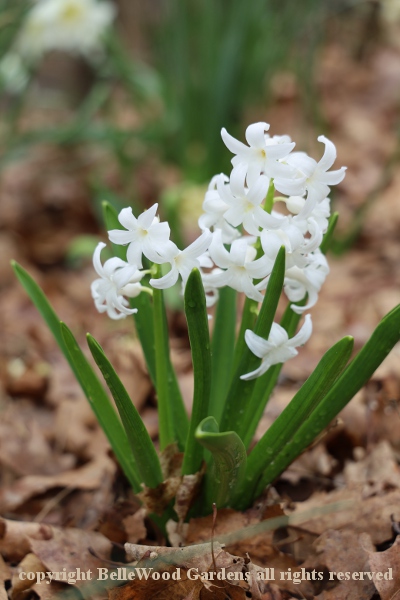
Another spring favorite, Hyacinthus 'Carnegie' with clean white flowers.
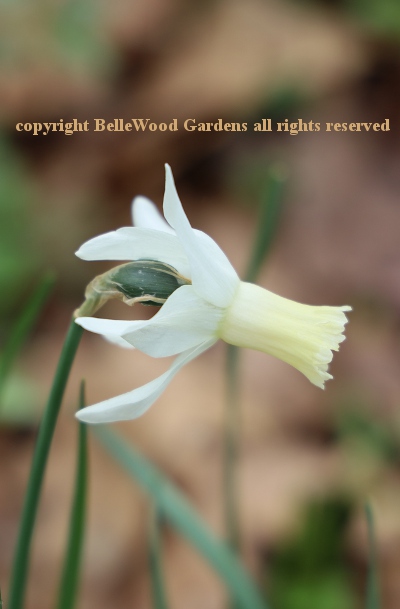
Narcissus 'Dove Wings' is another of the cyclamineus hybrids with
reflexed petals. The cup opens yellow, fades to ivory, then white.
Tuesday, 7 April 2020

As the star magnolia's flowers open the color softens to paler pink.
Wednesday, 1 April 2020

In my greenhouse. Freesia 'Mercurius', deliciously fragrant.
Tuesday, 31 March 2020

Magnolia stellata, like ballerinas, pink tutus spread as they twirl.
Friday, 27 March 2020

A blue hyacinth, a survivor that returns year after year. Not so club-like
and massive as newly planted bulbs. Still fragrant, still very welcome.

Anemone blanda may resemble a daisy. But in fact, it has nothing to do
with Compositae. It's in the Ranunculus family. Look alike, no relation.
Saturday, 21 March 2020

Magnolia stellata now spreading open furry calyces, white petals ready to unfurl.
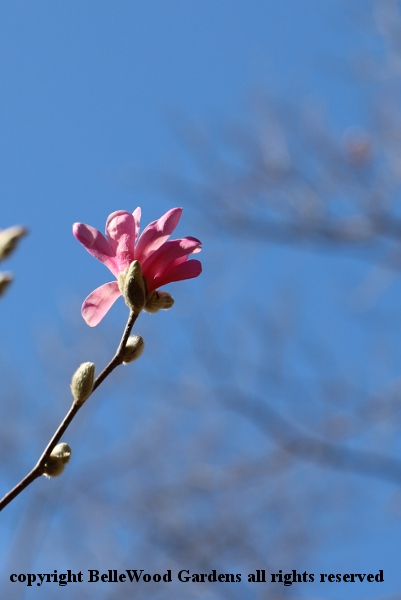
In a sunnier site my pink Magnolia stellata has a couple
so well open that I shall count them as flowers.
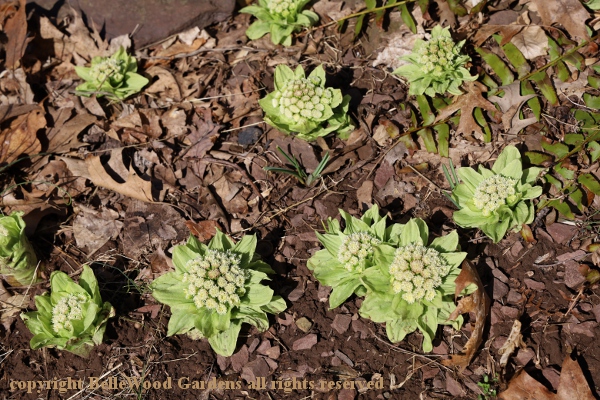
The flowers of Petasites japonicus look like a neat little tussie-mussie.
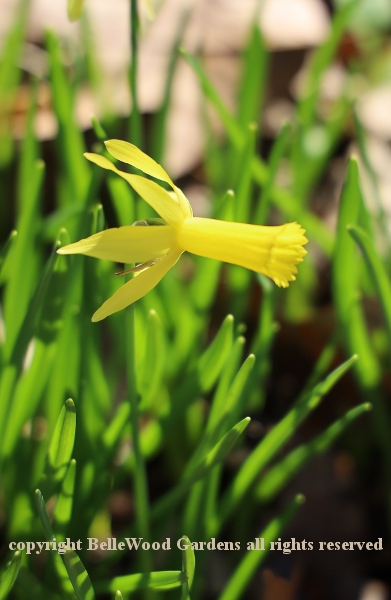
Narcissus cyclamineus is one of my favorite species daffodils,
with swept back petals indeed reminiscent of a cyclamen's bloom.

Narcissus 'Ice Follies' is a reliable, popular daffodil.

Where there was one or a few flowers of Helleborus niger now there are
groups, as sunny warm weather draws up buds and they open into full flower.

Like dapples of fallen sky, a charming group of Scilla bifolia.
Monday, 16 March 2020
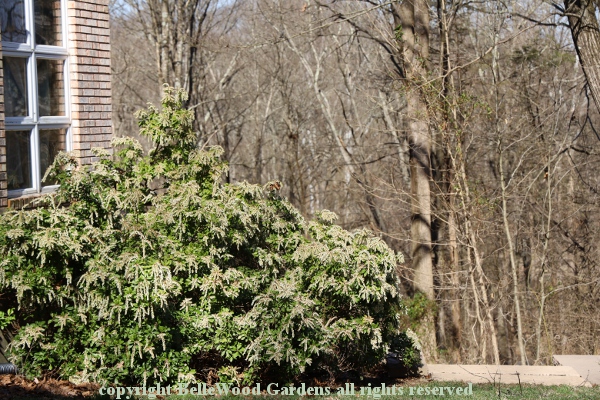 .
.
Shrubs are starting to flower also, such as this lovely Pieris japonicus. It amuses me
that this exotic Japanese "cousin" of our native species is easily obtained and widely
grown. But finding P. floribunda with its upright flower trusses is a difficult thing to do.
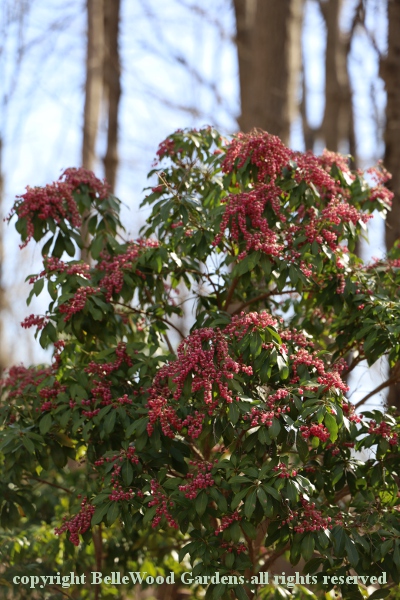
There are some interesting cultivars too, such as
P. japonica 'Valley Valentine' with red flowers.
Sunday, 15 March 2020

I am very fond of all the mahonia., for both their leathery, holly-like leaves and
clusters of early bright golden flowers that bees also enjoy. This is Mahonia bealii.

Perennials are waking up too. Lungwort, Pulmonaria saccharata
with its spotted leaves, pink buds that open up into blue flowers.
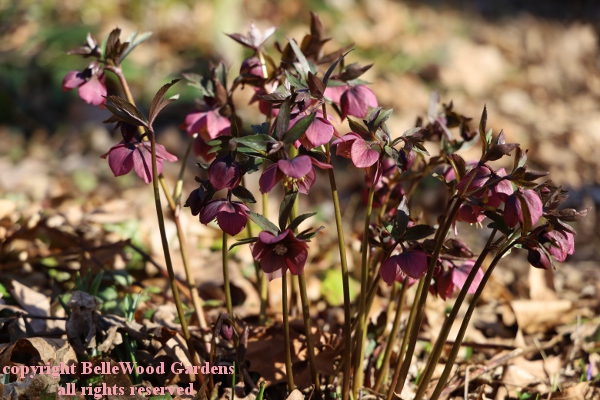
Hellebores continue to improve their displays as more and more buds mature into flowers.
Colors range from white to greenish white, pale to deep pink and even oxblood red, as here.

Christmas rose. We're well beyond Christmas. Whatever.
Helleborus niger, always white flowered, always welcome.

The clusters of dainty Scilla bifolia flowers may be small
but their starry sky blue hue offers a charming appeal.

Scilla tubergeniana is significantly larger but more subtle
look, the pale color of skim milk with a thin turquoise stripe.
 forbesii.jpg)
Names, they are a'changing. I learned this as a Chionodoxa
but it has now been lumped into Scilla, becoming S. forbesii.

Most of the snowdrops have now finished flowering. I did spot this
trio of Galanthus nivalis 'Magnet' with their long drooping petals.
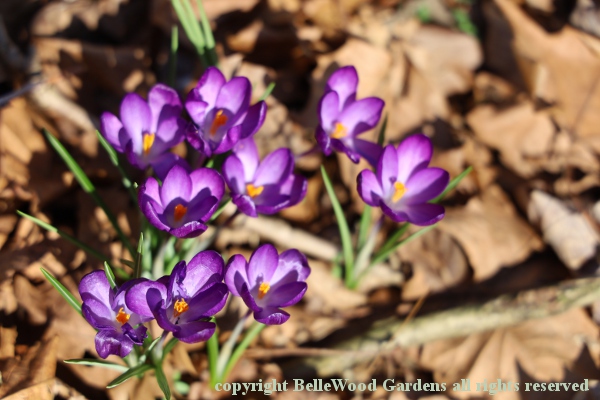
Not sure when or where I planted these hybrid, deep purple crocus. Bulbs do
move around here at BelleWood gardens. Squirrels? Crocus vernus cultivar.
Thursday, 5 March 2020

The furry buds of Magnolia stellata, fattening up, promise of flowers to come.

Masses of Eranthis hyemalis will soon vanish back underground until next spring.

Snowdrops are multiplying quite nicely, making large colonies with pristine white flowers.

Sunday, 23 February 2020

Another snowdrop, Galanthus ikariae latifolius. Easily distinguishable
by its glossy bright green leaves, rather than familiar gray green of others.
Monday, 17 February 2020
another Day and See! there are more Flowers!

Eranthis pinnatifida, a scarce, reluctantly increasing Japanese relative of
the exuberantly spreading, familiar yellow, E. hyemalis. Oh do hurry up!

Here is Crocus tommasinianus, a crocus that thrives in the shade. And how odd, this one
has eight petals rather than the typical six. I shall have to make a note to watch next year.
Saturday, 15 February 2020
Tho it still be Winter there are Flowers in my Garden

It was 7.7 degrees Fahrenheit the other night. Unharmed,
even more, so many more Eranthis hyemalis now appear.

Small differences distinguish galanthus cultivars.
This little beauty is Galanthus nivalis 'Virid Apice'

Lenten rose, Helleborus Early Purple Group opens its oxblood red flowers revealing ivory stamens.
Monday, 10 February 2020
Food stored in their underground "pantries" enables the little bulbs to spring into early growth and bloom, well before roots can access nutrients in the cold soil. Eager growth before trees leaf out and block the sunlight means woodlands awaken, quicken, before open meadows.
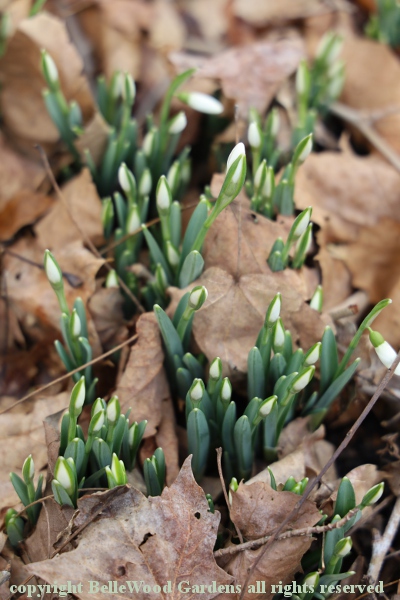
Snowdrops hurry, scurry, pushing up in groups, their paired, emerging leaves
protecting tender, membrane wrapped flower buds as they pierce the soil.

Even daintier, golden winter aconites, Eranthis hyemalis, each blossom perched
on a frilly green Toby ruff-like leaf, spread far and wide by means of light tan seeds.
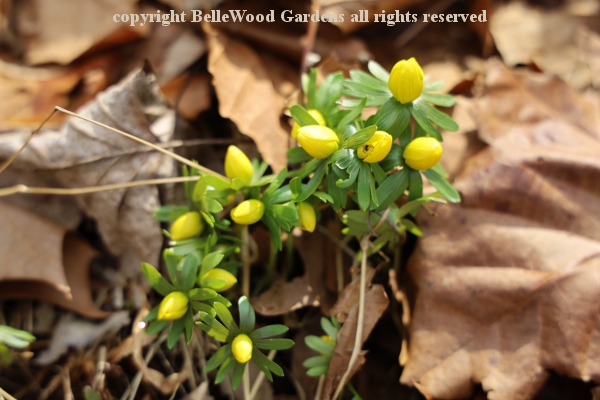
Closed in overcast conditions to keep their pollen dry, they'll open wide in sunlight.

The early Lenten roses, Helleborous Early Purple Group, shoves its buds
up from under fallen leaves. I need to clean up, but Friday will be colder.
Wednesday, 29 January 2020
The calendar still says it is winter. I went into the woods this afternoon and found flowers.
Does this mean it is spring? Probably not. But it is a hopeful sign.

This lovely trio is Galanthus nivalis 'Atkinsii'
Common names are schneetropfen, snow-drop in German, percé neige, snow piercer in French,
and in the UK, variously fair maid of February, or February fair maid in Somerset and Wiltshire
The Snowdrop
by Alfred, Lord Tennyson
Many, many welcomes,
February fair-maid,
Ever as of old time,
Solitary firstling,
Coming in the cold time,
Prophet of the gay time,
Prophet of the May time,
Prophet of the roses,
Many, many welcomes,
February fair-maid!
Bulbs have an edge, able to draw on stored food reserves underground
while the soil is still frozen and cold. Even so,

an early perennial, Helleborus ×ericsmithii, has buds and first flowers.